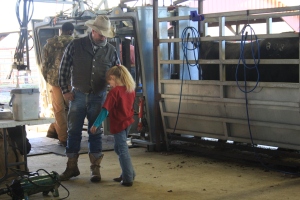There is never a day of the year that The Herdsman is idol. Twice a year we have calves born and at the same time he is breeding for the following calving season. Our calving season’s happens in the spring and fall. In the southern United States most purebred farms do not calve during the summer months. The humidity and heat index make birthing harder on the cow’s. A cow’s gestational period is 283 days from implantation. So if a cow is bred on December 13, 2013, it will have its calf on or around September 21, 2014. On the majority, purebred cattle are bred via Artificial insemination (A.I.). The benefit’s to A.I. are numerous when it comes to cost and health of the cattle. The process of insemination begins with synchronization of a group of cow’s or heifers so that they are on the same cycle of Estrus. Estrus often refered to as “heat”, is every 18-24 days for a sexual mature cow when they are receptive to being mounted by a bull or other cow’s. Recognizing this sign is a learned tool for a herdsman to know when the cow’s are ready to bred.
The Herdsman drives through his cow’s every day, twice a day. The farm does not use bull’s in the pasture to bred our cow’s, so The Herdsman looks for cow’s mounting each other among other sign’s. The mounting action is the best indication that a cow is ready to be bred. One tool that many people use are “heat” patches that are placed on the back of the cow just in front of the head of the tail. When they are placed on the cow they are grey with florescent orange writing. These patches are like lottery tickets in the since that when a cow mounts another cow it scratches of the grey film reveling the florescent orange tag.
Each cow has a predetermined bull she will be bred with. These selections are made based on genetic predisposition (blood lines) and how well the genetics will compliment each other. The person who makes these decisions has to be immersed in the blood lines and have a great understanding of genetics. Bull’s have their semen collected and placed into storage containers called “straws”. These straws are sometimes cooled for immediate use, but most of the time the specimens are frozen for when they are needed. Storage of the frozen semen is facilitated in an insulated portable tank that contains liquid nitrogen. The straws are placed into the tank and are arranged by donor. Many tanks are used so that a variety of bulls can be utilized in a breeding program. That is one of the major benefits to A.I.. Many different bulls can be used without having to own them or keep them up. It also gives any breeder the opportunity to use the best genetics for their breed. Using frozen semen also insures that when a bull dies or becomes unable to produce, his genetics will still be available. It’s also a great practice that keeps herd health optimal.
After The Herdsman pull’s the selected semen from the tank, he places it into the cow. I would go into detail, but it’s a lot of complicated terminologies. I can tell you that The Herdsman went to a special school to learn how to properly A.I. cow’s. He is very good at it and it usually only takes him one time to get a cow bred. He is really good at breeding heifers on the first time. This can be tricky because heifers cervix are not open as much as a cow and they are smaller a lot of times. The Herdsman had thirty-five heifers to bred just on Wednesday. The task can be time-consuming, so the girls and I visited with him before church. 
The Herdsman and I have always thought it to be important to involve our girls in everything on the farm. Even when it comes to breeding. Our oldest has known the difference between a bull and a cow since she was able to talk. She has an understanding of the cycle of life. The girls see how life is made during breeding, although we make it age appropriate in the explanations. We feel our girls have a better grasp on reality with their first hand experiences of life and death. They see new life when cow’s give birth to their calves. Death is also a lesson they see and how it can affect not just the old. They enjoy living on the farm and we couldn’t be happier that they share our love for the land and it’s inhabitants.




